Oct 30, 2007 | Society

As urban residents wield greater purchasing power, sophisticated shopping becomes an ever-important status symbol. Those at the top of Beijing’s increasingly stratified income brackets constantly seek to distinguish themselves from the rest of the pack. Conspicuous consumptive habits thus provide instant prominence and luxury companies are scrambling to cater to and expand upon every whim and desire. Designer clothing, sports cars, and jet-set vacations become necessary additions to any ostentatious parvenu enjoying the taste of once forbidden fruits.
This weekend I bore witness to the star-studded opening of Lane Crawford’s department store in Beijing. It’s a four-story behemoth in a glitzy mall and only stocks vogue international fashion designers. Apparently Beijing has stepped into the sartorial big leagues. Whether or not the store will make money is another question. Beijing doesn’t exude pretentious airs quite like Shanghai or Hong Kong yet. Local shoppers prefer to browse the racks and then hit the streets in search of similar black-market counterfeits. Still, this won’t stop major luxury brands vying to cash in on Beijing’s nouveau riche and their swelling materialistic obsessions. Too much is at stake in this potential market.
Unfortunately sipping on Moet all evening and ogling $5,000 USD Raf Simmons leather jackets can only provide so much enjoyment. Such prices smack of insolence considering the average income of rural farmers in China still tops out at around $225 USD per year according to the Xinhua News Agency. Even most city dwellers who average $750 USD per year would be left out of the commodity feeding frenzy occurring in department stores across Beijing. Many disenfranchised economic groups are starting to take action though, and the Chinese state is starting to realize the vast potential of widespread social unrest if income gaps continue to widen in favor of those already lining their closets with Givenchy, Paul Smith, and Prada. Even though the potential for a luxury backlash looms ever on the horizon, for now nothing seems to stand in the way of these corporate giants.
See “China’s hunger for luxury goods grows” for an excellent description of Chinese yuppies aka chippies.
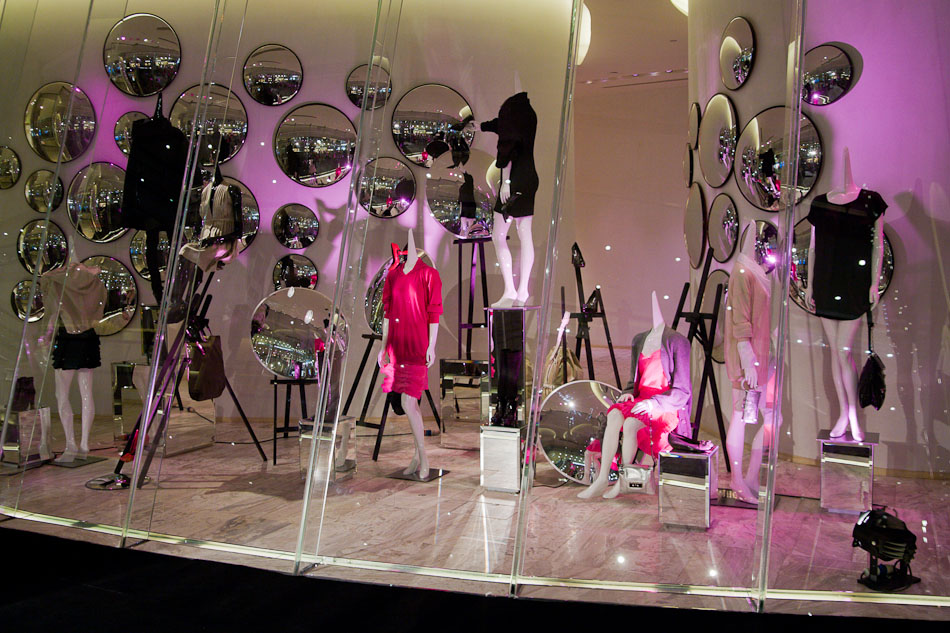
Sep 10, 2007 | Travel
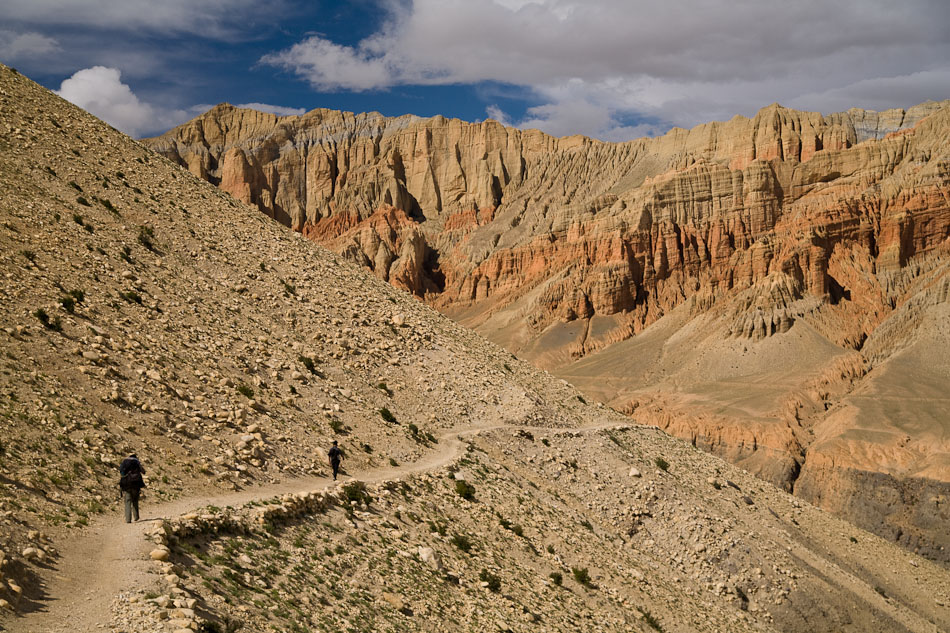
My recent foray into Mustang represented the culmination of many desires, interests, and frustrations I bear concerning the fate of contemporary Tibetan culture and Buddhism. This preoccupation first took hold while visiting Lhasa in 2001 after living in Beijing for a year. At the time I considered the long overland journey a pilgrimage to a center of faith that held the solution to many of the afflictions plaguing consumer culture and the developing world. Although my convictions certainly evolved over the years, that first encounter still left an indelible mark on my notions of cultural transformation in communities pried open and incorporated into the strata of modern nations.
Like many travelers before me, I first sought in Tibet the fleeting aura of a Shangri-La constructed under the influence of western media, and, like many travelers after me, I became deeply disappointed with the developmental scheme imposed on Lhasa by the Chinese state. Lifeless Tiananmen-esque squares and mindless concrete buildings dominated the Potala Palace and temples scattered about the city – religious institutions functioned in a nominal fashion and only insofar as they catered to the burgeoning tourist industry and ideological whims of local Communist Party representatives. Although some certainly welcomed much change, it could not be denied that this metamorphosis was imposed on Tibetans in a brutish manner.
My hope now is not that Tibetan culture be permanently shielded so that it may return to some traditional past but that they are finally given sovereignty over major socioeconomic decisions that impact their communities and family life. Fanciful notions championing the protection and containment of an idyllic Tibet of yore have long been lost to me. More pressing needs must be addressed as younger generations of Tibetans are forced into an often-alienating process of sinocization. Tibetans are consistently denied their supposed autonomous status more so than other officially designated ethnic minorities in China.
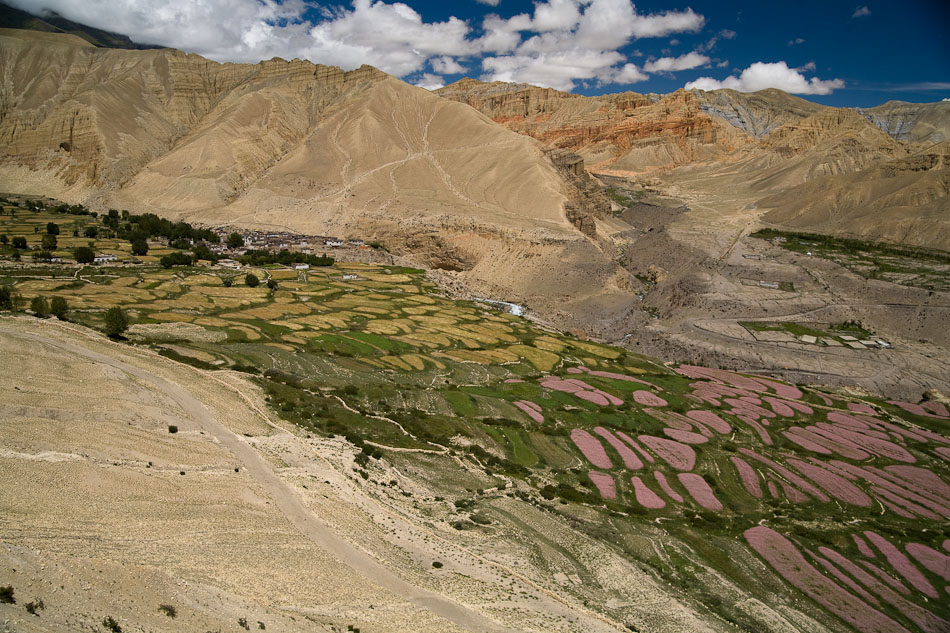
Mustang thus represented an anomaly of great curiosity to me. Situated along the Tibetan border in Nepal, communities within this ancient kingdom shared a longstanding linguistic and religious heritage with Lhasa. Although culturally bounded to Tibet, Mustang also maintained close political ties with Katmandu and aligned itself to Nepal when the People’s Liberation Army invaded Tibet in 1951. This propitious decision saved them from the vagaries of a Chinese state that systematically destroyed religious centers and social bonds throughout greater Tibet in the ensuing years. Mustang instead became a holdout for Tibetan insurgents and fiercely guarded the sanctity of its land and ancient way of life.
It was only in 1991 when the King of Mustang permitted tourists into the region that these communities slowly opened to the outside world. Even then, visitors allowed entrance each year were capped at a thousand and forced to purchase expensive permits (regulations that persist to this day). Mustang consequently earned the moniker the “Last Forbidden Kingdom” and prided itself on nurturing a distinct and unbroken heritage. I could not help but let such preconceptions tantalize sentiments I once held about Lhasa while walking up the Kali Gandaki Valley and first spotting the deep reddish hues of Mustang’s corrugated hillsides.
In a word, the hike was spectacular. For two weeks we crossed high passes providing sweeping vistas of bucolic villages penned in by irrigated fields of pink buckwheat and golden grains. These settlements split the arid valleys in a riot of color that was only intensified by the piercingly blue skies of the Himalayas. Every bend in the trail offered new marvels and the possibility of glimpsing the massive peaks of the Annapurna region hovering amongst the dissipating monsoon clouds in the south. Then, at the end of each day, we would settle into a local lodge that usually amounted to an extra room with a few wooden beds in a family home.
Aesthetically, Mustang did not differ greatly from rural towns in Tibet that managed to avoid the dull infrastructure development implemented by the Chinese state. Except for a number of restoration projects not much had changed over the centuries. Clustered villages consisted of whitewashed adobe houses crowned with fluttering prayer flags and interlaced with gurgling channels of water diverted from the surrounding hills. Only the impressive monasteries with their ruddy walls and ornamentation broke the ubiquitous flow of architecture.
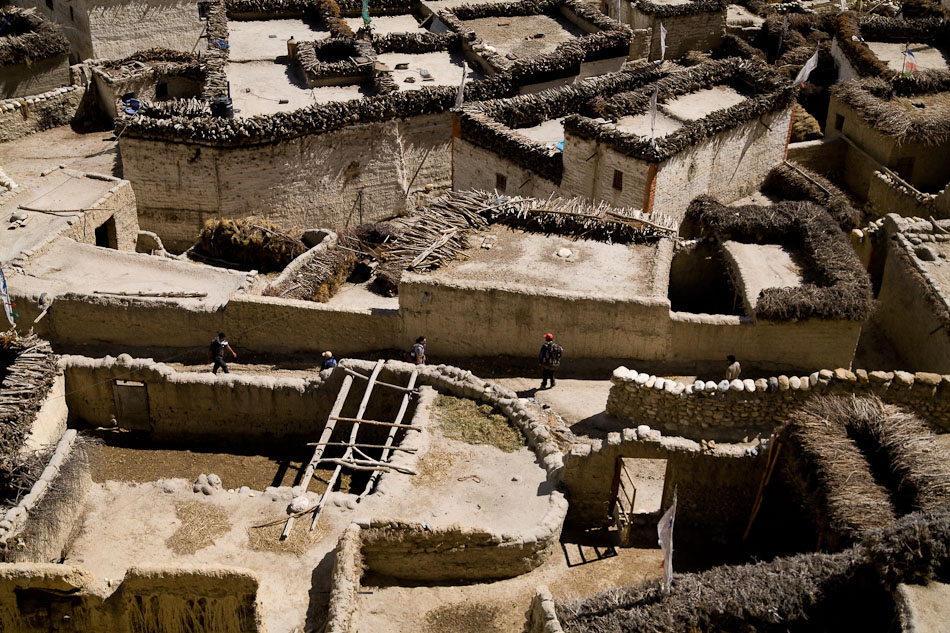
Although I was probably not the most disinterested observer, the one major difference I detected was a certain tranquility that pervaded the dimly lit rooms and cobbled courtyards of the houses in Mustang. These communities did not perpetuate the air of anxiety I constantly encountered in Tibet where an underlying current of fear still runs rampant. Mustang had largely escaped the violence and persecution suffered in Tibet over the past fifty years and did not show the lingering effects of a people uncertain of their present freedoms and future livelihood. In an incongruously dispirited manner, it came as a relief to me that even a small slice of Tibetan culture had escaped such a fate.
Communities are still bound to change in Mustang. The serenity that blanketed most of the region ruptured in many places as people expressed their impatience for roads, consistent electricity, and other important social services such as better schools and clinics. Residents do not wish to suspend themselves in a fixed bubble catering to the sentimental whims of tourists. Fortunately such decisions and the manner in which they are enacted are still in local hands. They are opening up in their own time and on their own terms – an opportunity usually not afforded to rusticated communities suddenly faced with the impositions of an outside world.
While stopping for lunch in a small village, we met a woman who had just returned from living in Queens for two years. She was cooking in the kitchen and totally indistinguishable from other residents in the valley with her native dress and manners. It therefore came as a shock when she started speaking to us in English and bantered with us about life in New York City. When asked as to why she returned to Mustang she merely gave us a small grin and simply stated, “I like living here better.” No further explanation was needed.
Jul 30, 2007 | Travel

Over the past year I have attentively bent my cartographic obsessions upon Central Asia. It represented a gaping hole in my world geography – a nebulous patch on the map boxed within more prominent regions. The puzzling jigsaw of borders, deserts, and inland seas nonetheless eluded any fixation in my mind. Even a month before my departure I could barely pronounce the names of areas I was to visit. I conjoined various syllables of neighboring countries and fed them to inquiring parties, “Yes, I will be visiting Uzbekistan, Tajikistan, and Tushkazilstan throughout August.” The amusing game made me feel better about my own ignorance, especially when people didn’t pick up on it. Newfangled post-Soviet republics convincingly sprang into existence on a nightly basis. It lent an air of mystery to the whole enterprise.
Despite such buildup the alluring bubble of Central Asia viciously popped while crossing from China into Kyrgyzstan. After struggling through initial immigration hurdles with a gaggle of rotund Uzbek ladies breathing heavily down my neck, two friends and I faced a five-kilometer stretch of hot tarmac before the first Kyrgyz outpost – a most unwelcoming no-man’s-land. Desperation soon set in after the same Uzbek ladies quickly snapped up the only empty seats in cargo trucks also waiting to clear Chinese customs and the ensuing barren expanse. All attempts to acquire spots of our own proved futile as passing drivers waved off our imploring gestures to board their vehicles. Nobody seemed interested in our plight.
Finally, after serious contemplation of crossing the inhospitable terrain on foot, a driver with a toothless grin beckoned us into his cab. We immediately crammed into the dingy compartment. Unfortunately, my initial joy upon scoring a ride blinded me to the predicament of his transport. Two trailers precariously balanced and strapped with cheap Chinese goods swung behind the ramshackle rig. The prohibitive weight of his haul limited our speed to about 5mph, thereby ruining any hope of a glorious entrance into Central Asia. Even the most stubborn mule would have easily left us behind in a wake of ruddy dust.
After an additional seven passport checks, two more hitched rides, and an officious interrogation regarding the intentions of my stay in Kyrgyzstan, I was finally in Central Asia. That fleeting moment of exultation was soon followed by more despair however. Border towns do not always lend the best impressions of a country, and the massive junkyard that comprised the frontier village offered no signs of enticement for the month of travel that lay ahead. Luckily an enterprising young girl selling meat pies took the edge of the whole escapade. Dusty and downtrodden, I nibbled on the tasty treat and peered about for a car to take our group to Osh.
Three hours later I was passing in and out of consciousness in the back of a small Russian jeep – every bump and rut on the haphazard road unfailingly slammed my head into the passenger window. My restless slumber finally came to an end when our driver stopped to assist another vehicle suffering massive engine failure. I stumbled out of the car only to be met with a vision more bizarre than the dream-fueled haze fading from my sensibility. A pastoral spread of yurts, farm animals, frolicking youth, and glossy Soviet trailers backdropped by the mighty Pamir Alay range spread out before us.
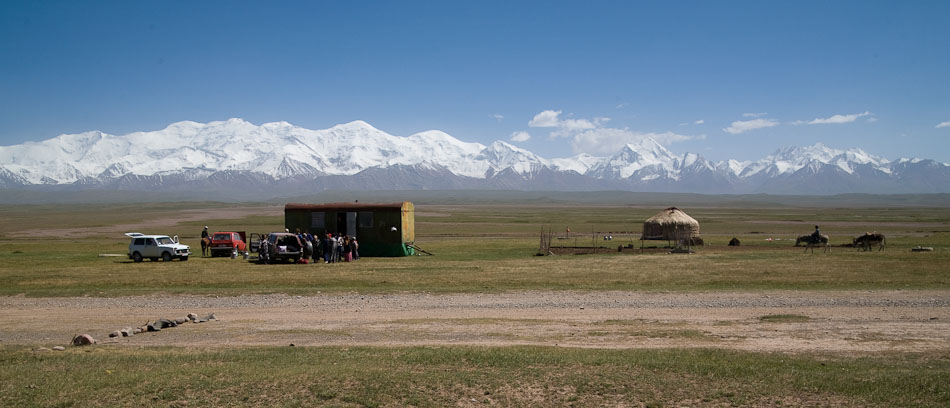
The proprietors of the peculiar estancia immediately offered us teeming bowls of yogurt and ushered us behind a trailer where we sat observing a young woman intently weaving thick bands of rope used to bind the slender frames of their yurts. The deft movement of her hands captivated me until a contumacious young burro disturbed my meditation, forcing me to chase him around the yard a few times. I had to cut my caper short though when the Uzbek ladies who so brusquely purloined our rides at the border that morning pulled up in their own jeep to rest and investigate the scene. I prepared myself for a mortal showdown.
Standing in the front yard with my bowl of yogurt and a clenched fist, I put on my most imposing visage. Like any hardened Asiatic traveler, I held longstanding grudges for anyone who broke queues and these particular offenders snagged our rides across the border without a hint of remorse. The Uzbek ladies, bedecked in gaudy robes and sporting flashy gold crowns on their teeth, took no notice of me however and quickly entered the trailer for a mid-morning snack. Noting their apparent disinterest, I continued my own exploration of the nearby area while our driver continued to slam the engine block of his friend’s car with a large mallet.
After playing with the rest of the farm animals including a gregarious brood of chicks that would expectantly clamor about your feet in search of food, loud accordion music started blasting from the front yard of the homely trailer. The Uzbek ladies had thrown open the doors of their jeep and instigated a dance party using a surprisingly loud stereo system. In spite of earlier resolutions, my ill will began to melt as the energetic pack of bodies bounced about the yard, wrists twisting into various exotic poses at every beat. They soon engendered a raucous wresting match amongst the children living in the yurt and attracted the expectant attention of neighbors on the surrounding hills. I could no longer harbor any discontent in the face of such impromptu revelry. Even lazy dogs enjoying afternoon naps emerged from their shady corners to bask in the energy of the boisterous crowd.
Thus, bowl of yogurt firmly in hand, my love affair with Central Asia firmly took root. The sentiment could not be resisted. I surrendered to the upbeat accordion music sweeping across the high plateau and threw my lot in with the spontaneous frivolities taking place around me. Such absurdities must always be embraced and I was in no position to refuse such a gift.
Jul 16, 2007 | Travel
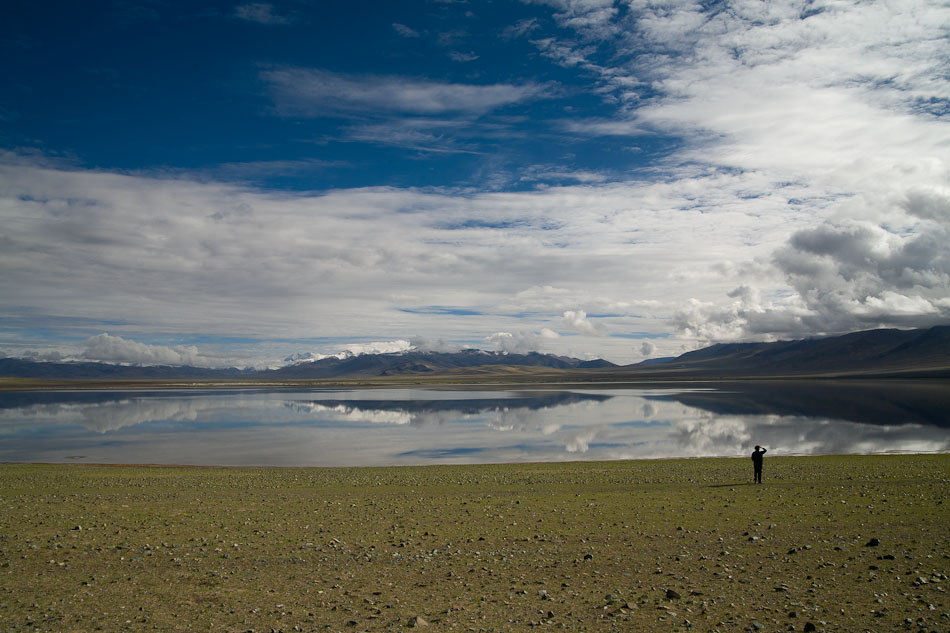
After the resplendent Tashilhunpo and Sakya monasteries, the road west from Lhasa soon enters one of the most remote regions in the world. Outside the infrequent villages only herders seeking high summer pastures inhabit the wide valleys spotted with electric-blue lakes. These desolate stretches of earth girdled by impenetrable snowcapped mountains engender a sublime trepidation, as if one has trespassed upon an inhuman landscape fit only for the gods and demons that adorn the walls of local temples. Here heaven touches the earth and yields Tibet its undisputed title as the roof of the world.
Western Tibet, known as Ngari, also remains a land of pilgrimages, chief among them Mount Kailash. For Hindus Mount Kailash is the domain of Shiva, Lord of the Cosmic Dance – both destroyer and creator. For Tibetan Buddhists Mount Kailash is the domain of Demchok, a wrathful manifestation of Sakyamuni – the historical Buddha who set the Dharma Wheel in motion some 2,500 years ago. For all faiths that venerate Mount Kailash the pilgrimage culminates in a ritual circumambulation of the mountain. Hardy locals complete the 32-mile circuit in a single day. Such a physical feat was not on my agenda however, especially with an extra thirty pounds of camera equipment strapped to my back.
I opted for a three-day trekking plan in order to stay at the monasteries en route and enjoy the views of Mount Kailash’s magnificent faces. Even with the extra time the trek was no small feat – the trail’s altitude averaged at about 15,000 feet and crossed a pass over 18,000 feet on the second day. These heights compounded by the occasional hailstorm added to the surreal surroundings. Luckily the rarefied atmosphere only amplified my lightheaded musings. Sore thighs and shortness of breath were quickly forgotten as I snacked at the summit of the pass with a group of other pilgrims looking to wipe away a lifetime of sins through their pilgrimage to the sacred mountain.
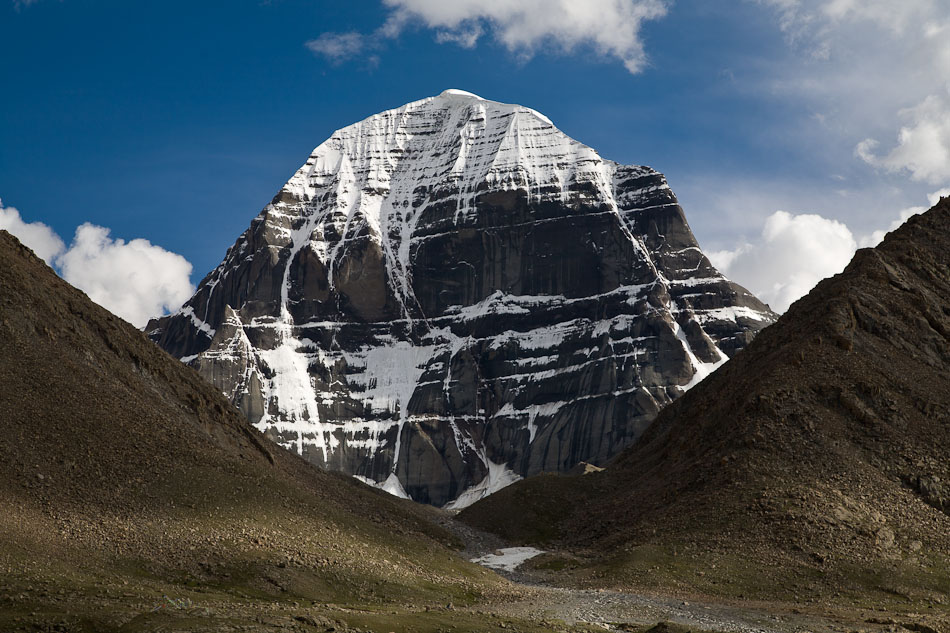
The descent proved more formidable. My legs turned into jelly near the bottom of the pass, making a long break at one of the many dark nomadic tents doling out tea and noodles necessary. Here I relaxed with a group of young Tibetan men dressed to the nines for the important pilgrimage – heavy woolen coats were complemented by polished leather cowboy hats and colored sunglasses that even Bono would be embarrassed to wear in public. Their modish attire clashed amidst the older pilgrims who unwaveringly twirled prayer wheels while whispering mantras to the deities dwelling atop the surrounding peaks.
The dark corrugated faces of elderly Tibetans exhibited decades of weathering at the hands of bitter winters and a piercing sun. Despite the Chinese state’s attempts to raise the quality of life for scattered provincial populations, a large majority of Ngari still relied on herding and sustenance farming for survival. The Tibetan plateau’s harsh environment forgave little in their lifetimes and the long pilgrimage to Mount Kailash represented for some the ultimate appeal for release. The past decade has been an especially incongruous time for them though. The specter of imposed socioeconomic reforms and their entailing skewed notions of progress loomed ever large on the horizon.
Ngari encompasses a major swath of bleak tundra that persists relatively untouched by the commercial markets spreading from Lhasa. Still, like Kham in the east, newly built roads are slowly opening insular communities. Increasing numbers of trucks and tourists ply these once isolated routes and bring with them an all too familiar stream of consumer goods and ploys. I can only hope that the decisions as to what manner and extent these areas open up to the outside world remain in indigenous hands – a liberty not often granted to these supposedly autonomous regions.
Jul 4, 2007 | Travel
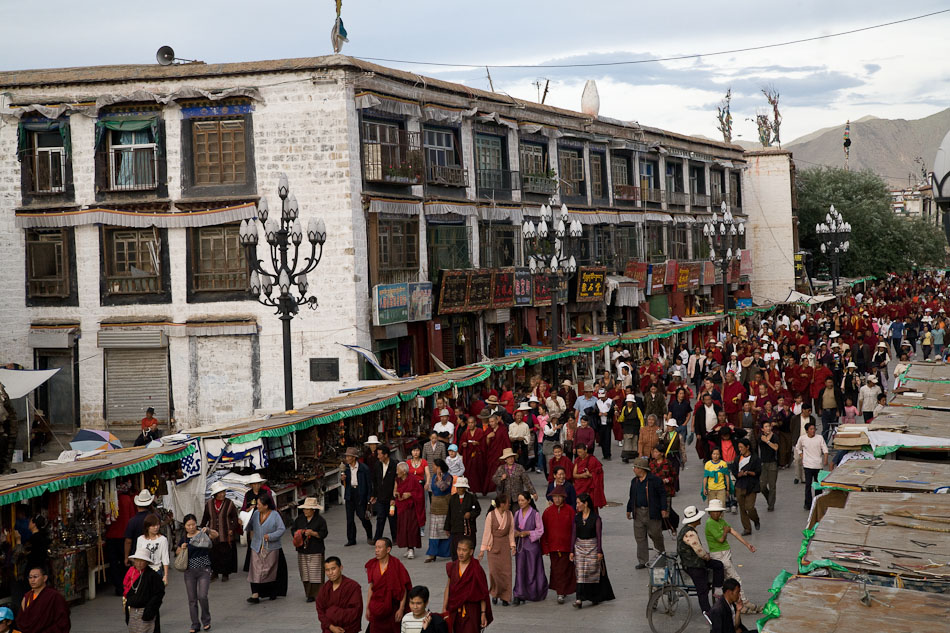
As the cultural center and capital of Tibet, Lhasa constantly remains poised to set the socioeconomic tone for the rest of the region. However, after a third visit over six years, characterizing that tone continues to evade me. Lhasa’s elusive nature never seems to resolve itself as the colorful Tibetan quarter continues to hold out against the encroaching conurbations inhabited by immigrating Han Chinese. Two years ago such architecturally uninspiring edifices seemed poised to swallow old Lhasa whole, but now I feel quite the opposite.
The Barkhor pilgrim circuit encompassing the Jokhang temple at the heart of the Tibetan quarter emitted a vivacity I had never felt before. On a daily basis thousands of pilgrims, monks, nuns, and awkward tourists rambled around the residence of the most revered Buddha image in Tibet. An odd cacophony emerged from the crowd as the murmur of prayers mixed with shuffling feet, congenial conversations, and the occasional resounding smack of pilgrims clapping their hands above their heads before prostrating on the ground. More importantly, the alleys surrounding the Barkhor teemed with Tibetans perusing small local markets and bustling about their daily business. I felt I had slipped into a vibrant Tibetan city instead of a fading relic of the past.
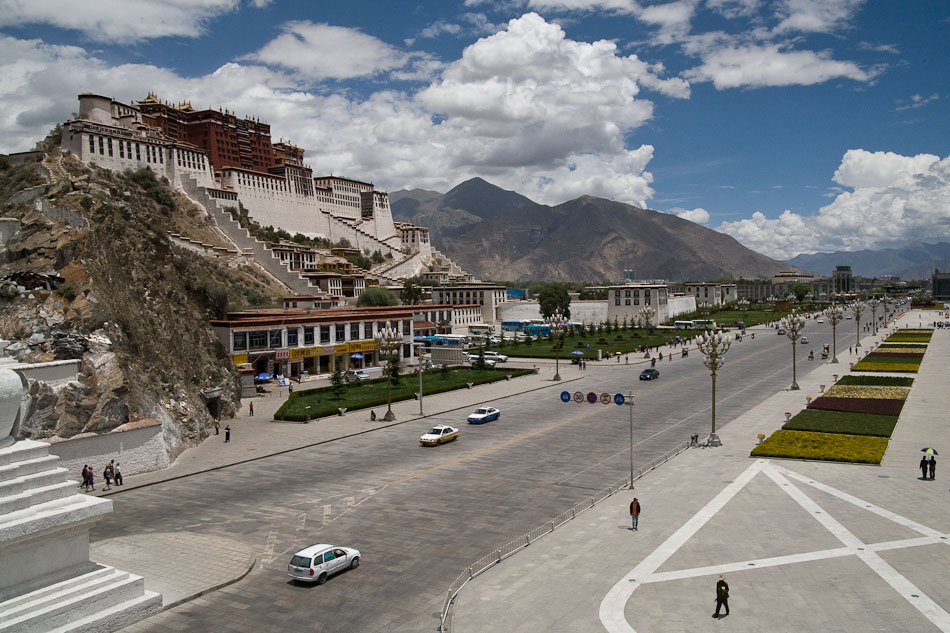
Since Tibet’s “peaceful liberation,” the Chinese state has largely committed itself to implementing “progressive” socioeconomic policies in Lhasa in hopes of bringing the rest of the region under more centralized control. Many indigenous customs were condemned while major religious institutions endured heavy censure and sometimes destruction in an attempt to redefine their identities and role in communities. For example, since the fourteenth Dali Lama’s 1959 exile into India, the Potala Palace was transformed into a state museum used to portray his presence as a figment of the past overcome by the ineluctable advent of modernity. Monks that attended the shrines were not even allowed to wear traditional monastic robes – the Chinese state did not want any indication that it still remained a functioning religious institution. Within the scope of socioeconomic progress, the Chinese state attempted to consign the Potala Palace to a bygone epoch just like the Forbidden City in Beijing. Still, its potency and ability to inspire awe remained, just as an undeniable resilience still prevailed within the Tibetan quarter.
Lhasa embodies an odd paradox posed by free market reforms and the rise of consumer culture introduced by the Chinese state. Newly built strip malls now crowd important temples and monasteries – centers of a faith devoted to self-abnegation and rarified spiritual pursuits. Nonetheless, a monk pulling a slick cell phone from beneath his robe no longer seems so strange a sight. Many religious institutions subsist on a very ambiguous line as mere tourist attractions and functioning monastic and spiritual centers. In all, generalizations continue to fail to capture this marvelous city as it persistently twists into a stranger synthesis of global influences and longstanding traditions.










